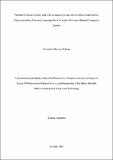| dc.description.abstract | Tanzania has huge deposits of scoria (S-N) and pumice (P-N) minerals that can be used as
supplementary cementing materials (SCMs) in cement factories to cut down the cost of cement
and its pollution effect to the environment. Besides this, agricultural wastes such as rice husk
produce rice husk ash (RHA) having high silica content that can be used with cement to reduce
the cost of cement and its impact to environment. Performance indicators of mortar and
concrete such as slump, flow, permeability, shrinkage, modulus of rupture, compressive and
tensile splitting strength were tested with different proportions of SCMs. It was found out that
in addition to cutting the CO
2
emissions, SCMs reduce energy bills and that they confer extra
strength and resistance to mortar and concrete. This work only examined the properties of
scoria (S-N) and pumice (P-N) and rice husk ash (RHA) as supplementary cementing materials
(SCMs) for Portland cement.
The investigation considered these materials in binary and ternary module. X-ray
fluorescence, X-ray diffraction, and pozzolanic activity index (PAI) tests confirmed the
suitability of these materials as potential SCMs. Initial and final mean setting times observed
for a binary composite cement were 166 and 285 min respectively. The setting times were
longer than those of Ordinary Portland cement (OPC) but shorter when compared to Portland
pozzolana cement.
Characteristic and target mean strengths of 30 and 38.2 MPa were considered. The
ultimate mean compressive strengths achieved at 28 days of curing were 42.5, 44.8, and 43.0
MPa for S-N, P-N, and RHA respectively indicating the potentials of these materials as SCMs.
Further observation show that, the 28-days maximum compressive strength achieved by the
blended cement concrete (with 10% replacement of SCMs) were 44.2 and 43.1 MPa for S-N
10 and P-N 10, respectively. The modulus of rupture decreased with an increase in the amount
of S-N. On the other hand with P-N, a maximum of 8.0 MPa at 20% replacement was observed but then dropped to a minimum value of 6.4 MPa at 40% replacement level. This indicated
potentially a superior ability of the P-N concrete to endure more sustained stress such as those
caused by tremors and earthquakes and impact-related stresses. The residual compressive
strength of P-N blended cement concrete samples, after subjection to a high temperatures of
600 ºC, was higher compared to S-N blended cement indicating the superior resistance of P-N
to higher temperatures. S-N 10, S-N 20 and S-N 30 gave coefficients of permeability, (K), of
5.2526E-08, 5.20833E-08, and 4.9741E-08 m/s, in that order. This low permeability was
attested by their dense microstructure, with implied reduced chemical attack, less carbonation,
improved steel protection against corrosion, and enhanced durability of the reinforced concrete.
The maximum compressive strength of ternary materials of 53.8 MPa was attained at
10/20% P-N/RHA replacement level. The 28 days Strength Activity Index (SAI) of S-N/RHA
blended cement at 30/0, 10/20, 5/25 and 0/30% S-N/RHA were above 75% recommended by
ASTM. On the other hand the SAI of P-N/RHA blended cement were higher than the ASTM
recommended value at all replacement levels. Therefore, 10% of S-N, P-N or RHA is
recommended as the optimum replacement for Portland cement in binary materials and 10/20%
P-N/RHA for ternary materials to enhance performance of cement. | en_US |


